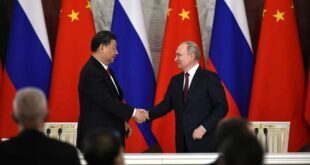Giancarlo Elia Valori
According to the data from the “Syrian Observatory for Human Rights” (a non-governmental organization based in London), in 2020 – after ten years of civil war – “only” 6,800 people were killed in Syria, the lowest figure since 2011.
In this long and bloody decade a total of 387,000 people died, of whom 117,000 were innocent civilians, victims of a war that began with a student protest and, in a short time, turned into a small “world war” that saw Turkish, Iranian, Russian and American forces in the field, besides the “local” contenders, namely Bashar al-Assad’s loyalist army and the various indigenous militias, ranging from the Kurds in the North-East to the jihadist militiamen of various complexion or background.
Considering the importance of Syria in the Middle East and in Mediterranean’s and North Africa’s equilibria, before analysing the possible developments of the geopolitical situation triggered by the conflict, it may be useful to go over the five phases in which the Syrian war unfolded, which turned out to be the most explosive and bloody consequence of the entire phenomenon of the so-called “Arab Springs”.
The first phase, in March 2011, was triggered by a demonstration of students in Deraa who, on the wave of the first protests in Egypt and Tunisia, took to the streets to demand the democratization of Assad’s regime, based on an Alawite leadership (a minority sect of Shi’ite origin) that for over forty years had been in power in a country where the Sunnis, traditional enemies of the Shi’ites, accounted for 65% of the population – as is still currently the case.
The police repression of student demonstrations was extremely harsh and, also thanks to a skilful information and disinformation campaign by Al Jazeera – the Qatari TV channel which is a master in defending the interests of the “Muslim Brotherhood” protected and supported by the Qatari Emir – the protests quickly spread throughout the country, while Assad’s forces tried to control them with the military iron fist.
Soon what looked like a re-edition of the French 1968 protest movements in Arab guise turned into a full-blown civil war.
In early 2012 there was the second phase of the crisis. The street protests turned into armed conflict due to the fact that better armed and better organized militias took the field, thanks to weapons and money from Qatar and Erdogan’s Turkey.
While the Syrian regime began to lose control of strategic territories in the North and in the South of the country, ceding the city of Aleppo to the insurgents, Iran – worried about the fate of the regime and the Alawite minority – had the Shi’ite militias of Hezbollah intervene in the conflict, from the neighbouring Lebanon, as well as “military advisers” from the “Islamic Revolutionary Guard Corps,” a powerful paramilitary organization created by the Ayatollahs to defend Iran’s interests abroad and the internal stability of the theocratic Republic.
In the spring of 2013, the Syrian regime appeared to be on the verge of collapse but, thanks to the Iranian help, it managed to maintain control of the capital and the strategic ports of Latakia and Tartus, in which a strong Russian naval presence was “hosted”.
The third phase marked the internationalization of the conflict, with the emergence of ISIS and the American and Turkish intervention.
In June 2014, faced with the total marginalization of the Sunni minority by the Shi’ite majority in Iraq, a Sunni political-military group composed of former Iraqi members of Saddam Hussein’s regime decided to establish the “Islamic State of Iraq and Syria”, a jihadist military organization aimed at building a new Sunni nation sitting astride two States considered “bastard” because they were conceived by Anglo-French colonialism.
The armed forces of ISIS, under the leadership of the “Caliph” Al Baghdadi, quickly conquered the city of Raqqa and territories in the North-East on the borders with Turkey and Iraqi Kurdistan, and initially thanks to the Turkish help they threatened to exterminate the Syrian Kurdish population and establish a bloody terror regime in the conquered areas.
The threat of ISIS led to the first American intervention, with targeted bombings in defence of the Kurds, while Turkey supported not only the Caliphate but also the creation of Sunni militias gathered under the name of “Jabhat Al Nusra”, that progressively reduced the control of the Syrian territory by the loyalist forces faithful to Damascus.
The fourth phase of the conflict started in 2015. The fate of Assad’s regime seemed doomed: the Damascus army did not even control the entire capital; the international isolation of the regime was almost absolute and the Sunni forces of ISIS and Al Nusraseemed destined to a victory that would deliver Syria to the fundamentalists and bring back to the centre of the Middle East scene a neo-Ottoman Turkey whose leader, Tayyip Recep Erdogan, pursued the dual goal of definitively cutting Kurdish irredentism down to size and ensuring Turkey the role of centre of gravity in the whole region.
At that juncture Russia directly entered the field with its own air force, siding with the Iranian forces deployed in defence of Assad, thus turning the tide of an increasingly confused and bloody conflict.
In the fifth and final phase of the Syrian war, thanks to the Russian military support, which almost led to a direct clash between Russian and Turkish forces, the Syrian armed forces not only regained total control of the capital but also of all the cities that had fallen under the control of ISIS and its allies, ranging from Aleppo to Raqqa, at the time reduced to a heap of rubble as a result of street fighting and Russian and American bombings.
The final conquest of Deraa – the symbolic city of the civil war – by Assad’s military forces at the end of 2018 marked the end of Sunnis’ and their internal and external supporters’ hopes to overthrow the secular Alawite regime in Damascus. However, as the 6,800 deaths in 2020 show, Syria cannot be considered pacified.
The Syrian civil war had significant impacts throughout the Middle East and Europe.
Over 3 million refugees poured into Turkey, the Lebanon, Jordan, Iraq and Egypt. Some of them arrived also in Europe via Greece, while Erdogan was “convinced” – with a donation of 7 billion euros – initially to curb and later to stop the flow of Syrian migrants to Europe.
Currently Syria is a country in ruins which, however, remains fundamental for the Middle East equilibria.
The role played so far in the conflict by Russia, Iran and Turkey and, albeit marginally, by the United States and Israel, shows that what appeared to be the “Arab Spring” in Damascus, was indeed an attempt to exploit the international unpopularity of Assad’s regime to alter the regional balance in favour of Turkey, Qatar and the most reactionary Sunnis.
Despite the Turkish military backlash that, in 2019, attempted to definitively eliminate the Kurdish threat from its borders by seizing Syrian territories, currently Syria is gradually integrating again into the Arab world.
It is a world that survived the impact of false “Arab Springs” which, badly analysed by a short-sighted and superficial West, were not initially understood in their most realistic sense, i.e. a well-orchestrated attempt by the most reactionary part of political Islam to overthrow the secular governments of the Arab-Muslim world.
Thanks to the efforts of Al Sisi’s Egypt, Syria is back again in the Arab League and has progressively resumed diplomatic relations with most Arab nations. With its support for Assad, Egypt is trying to curb the strong Iranian presence in the region and the unscrupulous activism of Turkish President Erdogan, who still dreams of becoming the “dominus” of the region.
The worst part of the Syrian war has come to an end. The Caliphate has been defeated militarily, but it still controls some parts of territory in the North-East of the country and is still able to carry out sporadic attacks against the regular armed forces.
Turkey remains a threat to the stability of Syria, a half-destroyed country, with a collapsing economy as a result of the U.S. sanctions and the Covid 19 pandemic.
Egypt, the Gulf States and Russia are working to bring Syria’s relations with the rest of the world back to normalcy, thus taking the first steps in the process of physically rebuilding a country in ruins. China and North Korea are also players in the game – a game that, in the future, will have important positive economic repercussions for the protagonists of the process.
For the time being, Europe and the United States have a wait-and-see attitude and are satisfied with maintaining a system of indiscriminate sanctions that have negative effects not on the stability of the regime, but on the well-being of its citizens.
After a decade of war, Syria has the right to peace and reconstruction – a complex process at which Europe should look with pragmatism and rationality, recalling the statement by Henry Kissinger that “in the Middle East there can be no peace without Syria”.
Giancarlo Elia Valori
Honorable de l’Académie des Sciences de l’Institut de France
President of International World Group
 Geostrategic Media Political Commentary, Analysis, Security, Defense
Geostrategic Media Political Commentary, Analysis, Security, Defense





